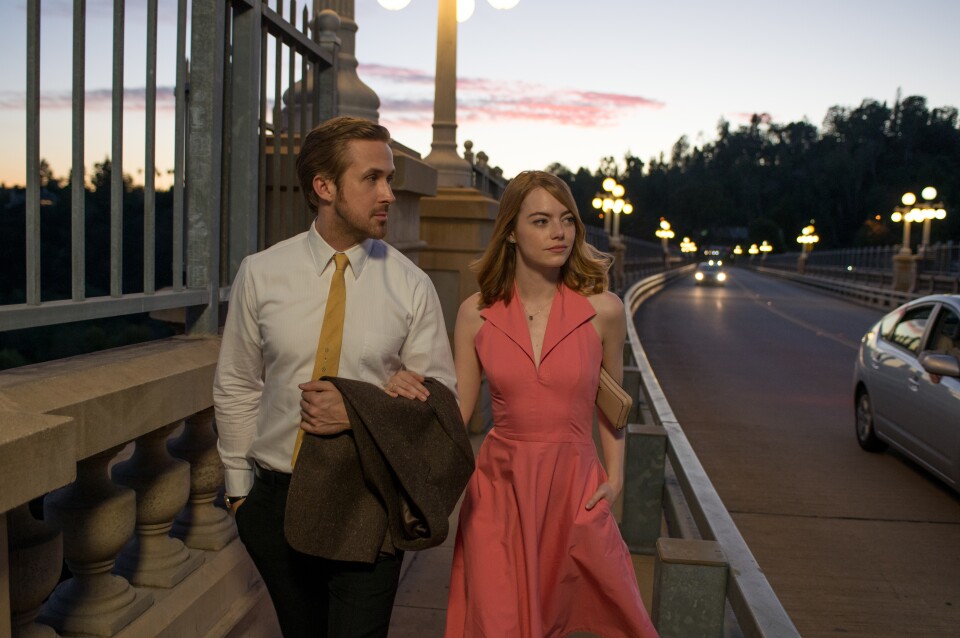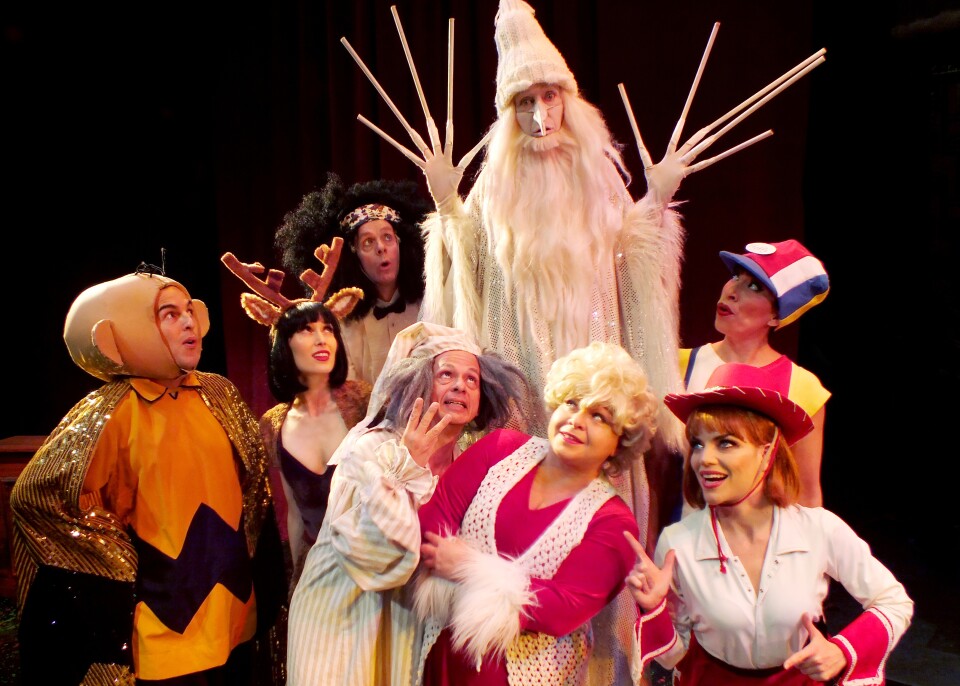Writer-director Damien Chazelle talks about directing Ryan Gosling and Emma Stone in his musical love letter to L.A.; Beyoncé leads the pack with nine nominations as hip-hop, rap and R&B dominate the Grammy list; an annual holiday musical at the Falcon Theatre adapts pop music into Christmas carols.
'La La Land' director Damien Chazelle taps into the unglamorous side of LA
The movie musical “La La Land” transforms some miserable experiences in Los Angeles into pure joy.
For instance, La La Land’s opening scene takes place on a freeway interchange, where in total gridlock, scores of dancers launch into an elaborate musical sequence.
The film was written and directed by Damien Chazelle. It follows two artists — Mia, a struggling actress played by Emma Stone, and Sebastian, an up-and-coming jazz pianist played by Ryan Gosling. The two sing and dance all around Los Angeles as they pursue their dreams and fall in love.
This isn’t the first time Chazelle has put music at the center of a film. His first feature, “Whiplash,” was about a jazz drummer and earned him an Oscar nomination for best adapted screenplay.
The Frame’s John Horn spoke with filmmaker Damien Chazelle about his love for movie musicals and how “La La Land” was influenced by the harsh realities that Los Angeles has to offer.
INTERVIEW HIGHLIGHTS
On the beginnings of “La La Land”
This is something that I wrote way before "Whiplash." It was based in germs of ideas that Justin Hurwitz, the composer, and I were brainstorming back in college when we were doing student movies. So we were exploring that terrain and always dreamed of doing that terrain. It started off as something that we hoped would get off the ground early as a low-budget thing, but it's very much the script that you see on the screen now.

On how Chazelle's personal relationship with Los Angeles influenced "La La Land"
I guess like a lot of people who weren't born in Los Angeles, but had moved [here], I have a continual love-hate relationship with the city. But I say that affectionately. It definitely veers more on the love side. But at the same time, you can't deny how awful it could be to sit in gridlock on the 405 or 110 [freeway] for an hour, or to be at a party where you feel like the loneliest person in the room. Or to feel like you're on the outside looking in.
It's a city that can make people feel that way in a very profound way — even more profound than other cities where life spills out onto the streets. There's less street life in L.A. so it can be isolating, it can be lonely. So I wanted to be very honest and upfront about that and not try and paint a sugar-coated love letter to the city.
I wanted to instead take the things that I actually found hard to deal with in L.A. and try to build from those [into] a love letter, so that you kind of go through the journey the characters go through, because they're not going through the easiest time either.
On shooting a lot of "La La Land" during twilight
Linus Sandgren, the director of photography, and I always talked about the skies in Los Angeles. L.A. is a very big sky city, partly because the buildings aren't that high. So there can be some spectacular skies in Los Angeles.
We were trying to get at the way film responds to color in a way that only film can. So we were talking about a lot of the old Technicolor movies from the '40s and '50s, and the saturation levels and the kinds of blues and reds and purples that you would see in those movies. So it made sense to use what the L.A. sky had to offer as opposed to relying on post-production or various other affects.
The whole idea of the movie was to try to do the kind of musical — in the old days, you would do entirely do in matte paintings and entirely on a back lot — in a real city on real locations, but we're still ultimately using the stuff of real life.

On why the musical genre became unpopular in film
Something happened in the '70s, and that something allowed for a lot of really amazing films to be made, but a taste for more reality entered into reality. Verisimilitude became a big thing in a way that it hadn't been as much before. So as soon as you got from the '60s to the '70s, musicals, which had grown very big — one could argue, bloated — didn't seem to have much of a place anymore.
So I think it has taken a long time to maybe come back around from that. I'd like to think that recently there is more appetite for movies in the musical sense of the term. I say this as a jazz lover: I don't think it's a coincidence that the moment that jazz stopped being the popular music of America is the moment that musicals started to recede at the end of the '50s and '60s.
“La La Land” opens in theaters on Dec. 9.
A theatrical holiday tradition gives David Bowie a musical makeover
This year’s holiday show at the Falcon Theater in Burbank is called "Little Drummer Bowie," and, as you can probably guess, it combines Christmas lyrics with David Bowie's music.
During one of the final rehearsals, the cast was working on the closing number under the eye of director Matt Walker, who joked about the reception they were going to receive.
“They’ll be throwing money and undergarments, try and keep a level head,” Walker said.
The Christmas show at the Falcon Theater has been going on since 2002 when they mounted
"A Christmas Carole King." And if you think it’s a simple matter of coming up with a title that includes a holiday theme and a popular musician, you’re not totally wrong.
“[We’ve done] 'It’s a Stevie Wonderful Life,'” Walker said. “'Santa Clause is Coming to Motown,' 'It’s a Charlie James Brown Xmas,' 'Frosty the Snow Mantilow.'”

But this show actually takes its inspiration from the stop-action animated TV special, "The Little Drummer Boy," that debuted back in 1968. Still set in the Middle East, it’s now a lot more about learning to be good to your fellow man than any manger-based miracle of birth. Joseph Leo Bwarie is Ziggy, the Bowie-inspired lead who had been playing Frankie Valli on Broadway before his old theater company called and asked if he wanted to come home for the holidays.
“Why does it work?” Bwarie asked. “Because it’s a rule breaker, and people want to party. It's similar to when I was in 'Jersey Boys,' and people would come ready for a party and they knew they were gonna get it. And we deliver that too — this feeling of freedom and not thinking of anything else.”
And the show almost always sells out. If you’re looking for tickets to the 130-seat venue, your best bet is to call in January. And Lisa Valenzuela, who plays Ziggy’s mother, said once you take your seats, just be ready.
Anything goes. You have a cold, and you’re sneezing, we’re gonna bless you, because that’s the kind of people we are, regardless of what’s going on.

But director Walker said their success is not just because of the show’s freewheeling approach. It’s also because they’ve become something that’s passed down not only generation-to-generation, but even neighbor-to-neighbor.
We’ve seen families of four, who’ll bring their neighbors. We have an Orange County group that’ll rent a tour bus and bring 60 of their closets friends. It’s become an outing. People dress up and heckle us in a good natured, spirited way — sort of bring in the joy and yuletide craziness.
By the way, you will hear the music for David Bowie and Bing Crosby's "Little Drummer Boy/Peace on Earth" duet in the show, but don’t expect to recognize a lot of lyrics. By changing up the words, the cast can belt out familiar tunes thanks to the fact that they’re considered parody. Which means not only can the show go on this year, but with record company lawyers at bay, there’ll likely be something new to come back for next season.
"Little Drummer Bowie" is at the Falcon Theater in Burbank through Jan. 15.




